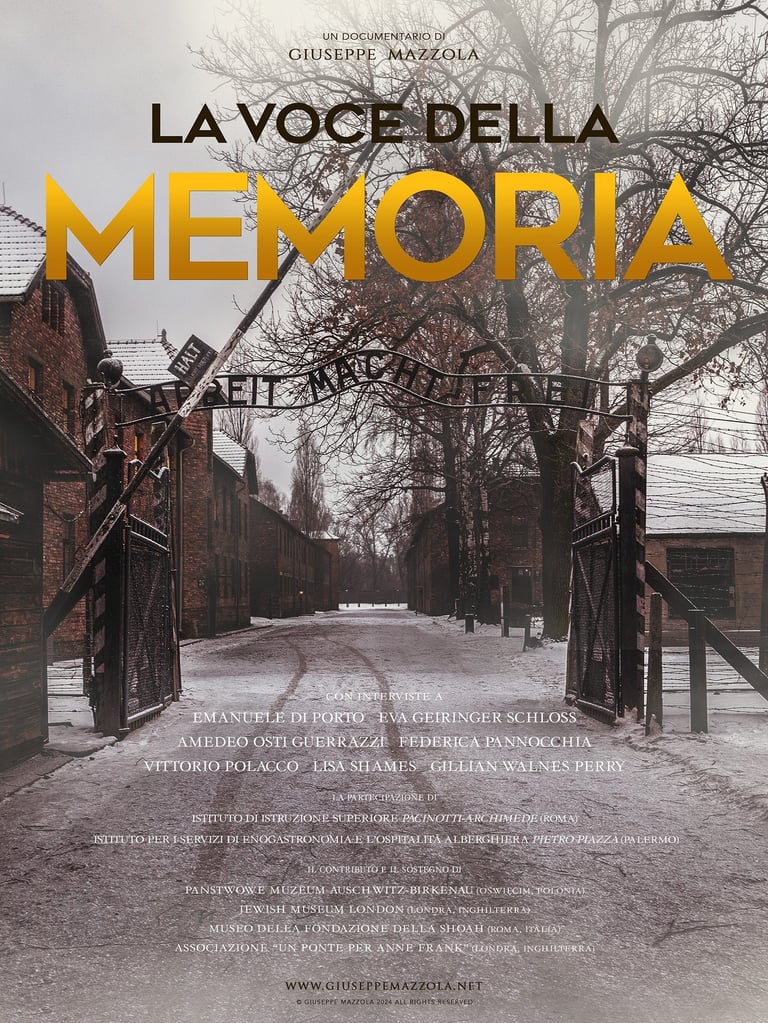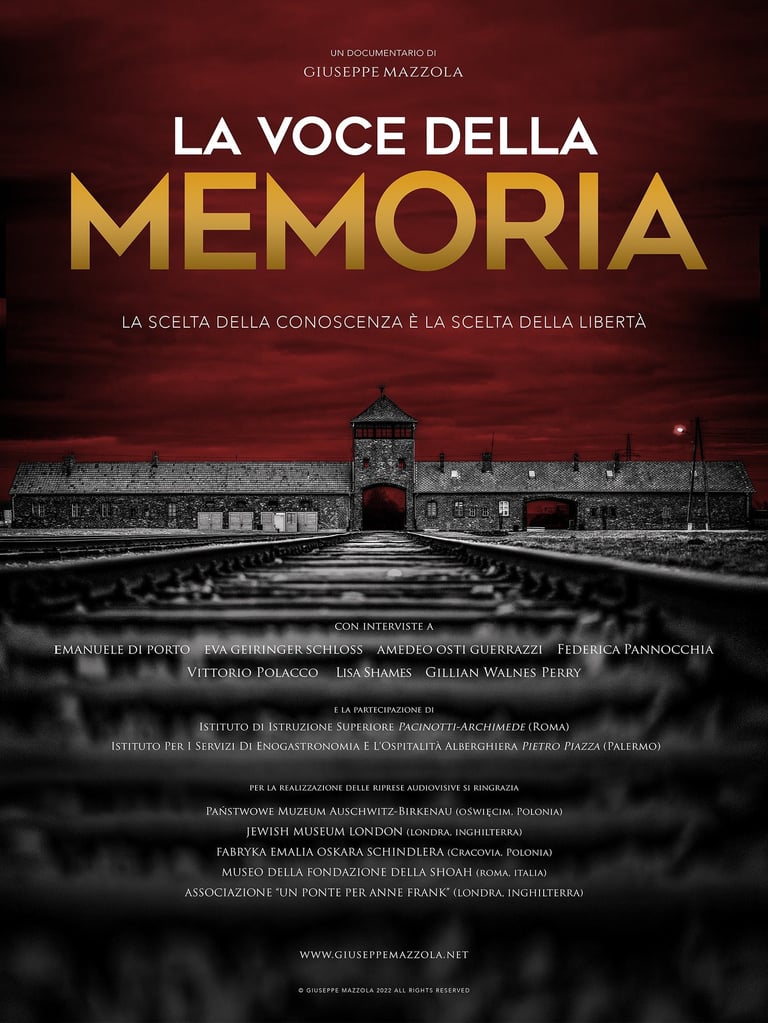la voce della memoria press release
The official press release with all the information regarding the history, production and participants in the documentary. In Italian and English.


La Shoah è stato il più grande disastro dell’humanitas, una scelta condivisa di trasformare l’odio in un’ideologia culturale sistematica,paradigma della volontà del male più assoluto, e ha portato alla morte di milioni di persone e che oggi viene ricordata ogni anno il 27 gennaio in occasione della Giornata della Memoria della Shoah.
A 79 anni dalla liberazione del Campo di Sterminio Nazista di Auschwitz, l’epoca della Cultura dell’Odio non è ancora stata sconfitta.
Il ritorno alla libertà e alla dignità di milioni di prigionieri, la fine di un’ideologia fondata sulla negazione (dell’umanità) e sulla separazione (da ogni diritto all’esistenza) ha segnato il declino di un’epoca dettata da guerre, genocidi e dittature; ha assistito alla rinascita del pensiero umano, più attento alla tutela dei diritti umani, ma non ha delineato, in termini politici e sociali, un nuovo percorso per l’umanità abbastanza forte da impedire il rischio di un ritorno al passato.
Razzismo, bullismo, omofobia, crimini perpetrati nel nome della religione e dell’etnia, violenza di genere e femminicidi, violazione dei diritti umani, appartengono a un linguaggio, che dilaga in ogni contesto geografico, culturale, politico e sociale, le cui radici sono sempre più difficili da sradicare.
La Voce Della Memoria, ideato e realizzato da Giuseppe Mazzola, è un docu-reportage filmato fra Italia, Polonia e Regno Unito, nasce da questa consapevolezza di emergenza e dal bisogno di mantenere alta l’attenzione sull’importanza dell’ascolto e del confronto, per riflettere su quanto la Memoria ci vuole insegnare, e per individuare gli strumenti da adottare per affrontare e contrastare l’odio e ogni sua forma di discriminazione.
Esso ci concede un affresco autentico della Shoah e delle sue dinamiche di attuazione e mutazione nel corso del tempo; non tenta di fornire ulteriori risposte che non siano già state ampliamente soddisfatte da storici e studiosi, ma ci esorta, attraverso l’eredità che la Memoria concede, a porre e a porci domande.
Due, tra le tante, accomunano e pervadono le testimonianze, le opinioni e le Voci del film: Perché è stata possibile la Shoah? Cosa possiamo fare oggi affinché non si ripeta?
Due sono i punti di riferimento, leit motiv e filo conduttore del film: la Memoria e l’Istruzione. La prima mette in luce l’identità dell’Umanità; la seconda scava nelle intenzioni dell’essere umano, per trovare una via di superamento dall’oblio dell’ignoranza.
Per fare tutto ciò, Giuseppe Mazzola ha visitato per sette anni i luoghi della Memoria in Europa; filmato e documentato i simboli dello sterminio nazista; incontrato, dialogato e raccolto testimonianze e confidenze di sopravvissuti alla Shoah, Storici e ricercatori, attivisti ed educatori, studenti e studentesse.
La Voce Della Memoria si avvale delle preziose testimonianze di: Vittorio Polacco ed Emanuele Di Porto, sopravvissuti al Rastrellamento del Quartiere Ebraico di Roma; di Eva Geiringer Schloss, sopravvissuta ai Campi di Sterminio di Auschwitz-Birkenau, sorellastra di Anne Frank e co-fondatrice (insieme a Otto Frank, padre di Margot e Anne) dell’Associazione britannica “Anne Frank Trust”.
Approfondiscono e indagano il significato e il valore della Memoria: Amedeo Osti Guerrazzi, Storico e Ricercatore presso la Fondazione Museo della Shoah di Roma; Lisa Shames, Responsabile dell’Istruzione presso il Jewish Museum di Londra; Federica Pannocchia, fondatrice e direttrice dell’Associazione “Un Ponte Per Anne Frank”, oltre che scrittrice; Gillian Walnes Perry, co-fondatrice dell’Associazione “Anne Frank Trust”, scrittrice di numerosi libri su Anne Frank e oratrice impegnata in eventi con le più alte cariche a livello mondiale.
La partecipazione di studenti e docenti, i guardiani della Storia e della Memoria, apre una finestra sulla necessità di dialogo, apprendimento, istruzione e confronto come lotta quotidiana contro l’Indifferenza, come percorso di conoscenza per riscattare, attraverso un lavoro incessante di istruzione, divulgazione e sensibilizzazione, milioni di vite spezzate dalla brutalità della Cultura dell’Odio e, di conseguenza, riflettere e discutere su come costruire una Cultura Anti-Odio.
Per concessione del Państwowe Muzeum Auschwitz-Birkenau è possibile vedere: alcune aree non accessibili del Campo di Sterminio di Auschwitz-Birkenau, in assenza di visitatori; il Ghetto di Kazimierz, la Sinagoga Remuh e l’antico cimitero a Cracovia; la Fabbrica/Museo di Oskar Schindler; le Sale dell’Olocausto presso il Jewish Museum di Camden a Londra; il Quartiere Ebraico di Roma.
Il filmato è in continua evoluzione e aggiornamento, così che la Shoah non corra il rischio di essere considerata una faccenda chiusa, un pretesto per voltare pagina e non tornare più sulla questione. Esso rimane volutamente un capitolo aperto, una pagina bianca nella quale è possibile scrivere l’inizio di un nuovo capitolo, trama della Pace, ambientato e intitolato “Nel Presente”.


The Shoah was the greatest disaster of humanitas, a shared choice to transform hatred into a systematic cultural ideology, that led to the death of millions of people and which today is commemorated every year on January 27th on the occasion of Shoah Memorial Day.
79 years after the liberation of the Nazi extermination Camp Auschwitz-Birkenau, the era of the Culture of Hate has not yet been defeated.
The return to freedom and dignity of millions of prisoners, the end of the Nazi regime and the Second World War, marked the end of an era dictated by wars, genocides and dictatorships. A new era is born, characterized by the (illusory) rebirth of human thought, more attentive to the protection of human rights, but which has not outlined, in political and social terms, a new path for humanity strong enough to avoid the risk of a return to the past.
Racism, bullying, homophobia, crimes perpetrated in the name of religion and ethnicity, gender violence and femicides, violation of human rights, belong to a language, which spreads in every geographical, cultural, political and social context, whose roots they are increasingly difficult to detect. eradicate.
The Voice of Memory, conceived and created entirely by the Italian photoreporter Giuseppe Mazzola, is a docu-reportage filmed between Italy, Poland and the United Kingdom, which arises from this awareness of the emergency and the need to maintain high attention on the importance of listening and of comparison, to reflect on what Memory wants to teach us, and to identify the tools to adopt to address and combat hatred and all its forms of discrimination.
It gives us an authentic fresco of the Shoah, and its dynamics of implementation and mutation over time; not to provide us with further answers that have not already been amply satisfied by historians and scholars, but to urge us, through the legacy that Memory grants, to ask ourselves and ask ourselves questions.
Two, among many, unite and pervade the testimonies, opinions and voices of the film: Why was the Holocaust possible? What can we do today to ensure it doesn't happen again?
There are two points of reference, leitmotif and underlying theme of the film: Memory and Education. The first highlights the identity of Humanity; the second delves into the intentions of the human being, to find a way to overcome the oblivion of ignorance.
To do all this, Giuseppe Mazzola visited the places of remembrance in Europe for seven years; filmed and documented the symbols of Nazi extermination; met, discussed and collected testimonies and confidences from Shoah survivors, historians and researchers, activists and educators, male and female students.
The Voice of Memory makes use of the precious testimonies of: Vittorio Polacco and Emanuele Di Porto, survivors of the roundup of the Jewish Quarter of Rome; by Eva Geiringer Schloss, survivor of the Auschwitz-Birkenau extermination camps, half-sister of Anne Frank and co-founder (together with Otto Frank, father of Margot and Anne) of the British Association "Anne Frank Trust". Deepening and investigating the meaning and value of Memory: Amedeo Osti Guerrazzi, Historian and Researcher at the Shoah Museum Foundation in Rome; Lisa Shames, Head of Education at the Jewish Museum in London; Federica Pannocchia, founder and director of the “A Bridge For Anne Frank” Association, as well as writer; Gillian Walnes Perry,co-founder of the "Anne Frank Trust" Association, writer of numerous books on Anne Frank and speaker at events with high authorities worldwide.
The participation of students and teachers, the guardians of History and Memory, opens a window on the need for dialogue, learning, education and discussion as a daily struggle against Indifference, as a path of knowledge to redeem, through incessant work of education, disclosure and awareness, millions of lives broken by the brutality of the Culture of Hate and reflect and discuss how to build an Anti-Hate Culture.
By permission of the Państwowe Muzeum Auschwitz-Birkenau it is possible to see: some non-accessible areas of the Auschwitz-Birkenau extermination camp, in the absence of visitors; the Kazimierz Ghetto, the Remuh Synagogue and the ancient cemetery in Krakow; the Oskar Schindler Factory/Museum; the Holocaust Rooms at the Jewish Museum in Camden in London; the Jewish Quarter of Rome.
The film is constantly evolving and updating, to ensure that the Shoah does not run the risk of being considered a closed matter, a pretext to move on and never return to the issue.
It deliberately remains an open chapter, a blank page on which it is possible to write the beginning of a new chapter, the plot of Peace, set and entitled "In the Present".